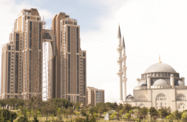The Turkish government is hoping talks aimed at ending the long-running conflict with Kurdish separatists will bring not only peace to the east and south-east of the country but also a wave of investments, with the industrial sector tipped to be one of the main beneficiaries. However, it will take many years to redress decades of underdevelopment, and close cooperation will be required if the region is to benefit from potential investment.
The Turkish state and the Kurdistan Workers’ Party (PKK), a group deemed to be a terrorist organisation by Turkey, the US and the EU, have been in conflict for 30 years, at the cost of some 40,000 lives and hampered economic development in the south-east region. After a couple of false starts, Ankara has entered into negotiations with the PKK’s imprisoned leader, Abdullah Ocalan, in an attempt to seek a resolution.
On March 21, 2013, a message from Ocalan was read out in Diyarbakır, south-eastern Turkey’s main city, calling for a ceasefire and a withdrawal of PKK forces. Although Ocalan stopped short of calling on the PKK to disarm, this was the biggest step yet taken towards a deal. This was followed in late April by an announcement from the PKK’s military leader, Murat Karayılan, that the outlawed group’s fighters would begin to withdraw from Turkey in early May 2013.
A ceasefire is just the first step to ending the conflict. With the south-east lagging behind the rest of the country on most social and economic indicators – problems that have helped fuel the conflict – vast investments will be required to overcome long-standing imbalances. Turkey’s ruling Justice and Development Party has said it sees improving the economic conditions in the region as vital to sustaining the peace it is seeking to broker.
In April 2013, Mehmet Şimşek, the minister of finance, said if the talks result in an end to the conflict, the funds previously directed to fighting terrorism can be invested in education, infrastructure and industrial projects. This funding will help redress the social and economic imbalances and boost development, he said.
Disparate income levels perhaps best illustrate the lack of development in the region. According to the latest report on wealth distribution by Turkstat, the national statistics agency, the average annual disposable income in the south-east is just half that of the national level. However, this figure falls to about one-third when the provinces of the region are compared to Istanbul, the economic centre of Turkey, further reflecting the divide between east and west.
Nihat Ergün, the minister of industry, said in late March that an end to the conflict will serve to revitalise the region’s economy. According to Ergün, there has already been an increase in the flow of investment in the province of Diyarbakır, which has the largest number of Kurdish citizens and has seen some of the most heated clashes over the past 30 years. There has been a tenfold increase in investments in the province in the first quarter of 2013, the minister said, with commitments of around $1bn made.
If a comprehensive deal can be reached, there will be strong opportunities for investment in the region, particularly for agriculture and the food-processing industry. The south-east region is fertile and, before the conflict, provided much of Turkey’s meat, pulses and fruit. While the livestock segment suffered in the 1990s, peace and greater investment in primary production should help to broaden the base of the food-processing sector.
Industry will also benefit from ample supplies of electricity. The South-eastern Anatolia Project – a regional economic development programme that includes, among other aspects, a series of 21 dams and hydro-electric power stations being developed on the Tigris and Euphrates rivers – combined with the extension of the natural gas pipeline grid to the south-east, should meet industry’s requirements. Recent reports in the Turkish media also suggest the Diyarbakır region may have extensive deposits of shale gas, which could not only spawn an industry of its own if commercially viable but could also help underpin broader industrial growth in the region.
There are some downsides, however, that investors will need to consider. For example, the lack of access to sea transport will be a major drawback. Many of the country’s heavy industries, such as the automotive sector, are reliant on imports to feed production and exports for their markets, which requires access to a sea port. While other logistics links are in place, the south-east could benefit from improved rail connections, which will be increasingly in demand if industrialisation in the region proceeds apace.
The government’s bid to resolve the conflict is still in its early stages, and is being met with much scepticism from the main opposition parties, which see the initiative being driven by short-term political imperatives – with local, parliamentary and presidential elections due in 2014 and 2015 – rather than longer-term social and economic ones. If peace is achieved, however, the country’s industrial sector could be one of the winners.

